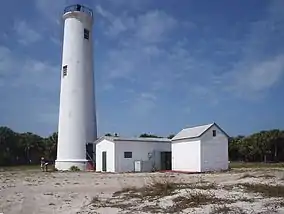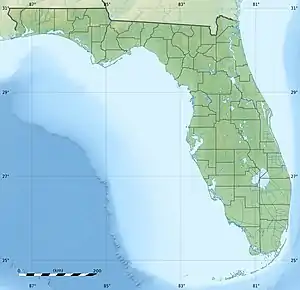Egmont Key State Park and National Wildlife Refuge
Egmont Key State Park is a Florida State Park located on Egmont Key, at the mouth of Tampa Bay, in the state of Florida, United States. It lies southwest of Fort De Soto Park and can only be reached by boat or ferry. The Egmont Key Lighthouse and the ruins of Fort Dade, a Spanish–American War era fort, are located in the park. Egmont Key is in Hillsborough County in a narrow strip of the county that extends along the Tampa Port Shipping Channel.
| Egmont Key State Park & National Wildlife Refuge | |
|---|---|
IUCN category IV (habitat/species management area) | |
 | |
 Egmont Key State Park & National Wildlife Refuge | |
| Location | Hillsborough County, Florida, United States |
| Nearest city | St. Petersburg, Florida |
| Coordinates | 27.58625°N 82.761389°W |
| Area | 328 acres (1.33 km2) |
| Established | 1974 |
| Governing body | Florida Department of Environmental Protection |
| Website | Egmont Key State Park |
Egmont Key | |
| Coordinates | 27°35′24″N 82°45′46″W |
| Area | 450 acres (182 ha) |
| Built | 1840 |
| NRHP reference No. | 78000946[1] |
| Added to NRHP | December 11, 1978 |
Located on the south end of the island is the Egmont Key National Wildlife Refuge, was established in 1974. The entire 328 acres (133 ha) island is actually part of the Refuge.[2] It is one of the three 'Tampa Bay Refuges', along with Passage Key NWR, and the Pinellas NWR, that was administered as a part of the Chassahowitzka National Wildlife Refuge Complex but changed to the Crystal River Complex headquartered in Crystal River, Florida. The complex also manages the Crystal River NWR.[3]
Egmont Key was added to the U.S. National Register of Historic Places on December 11, 1978.
Fauna
Among the wildlife in the park are gopher tortoises, hummingbirds, and seabirds.
Recreational activities
Activities include sunbathing, swimming, shelling, boating, picnicking, snorkeling, touring the fort, and wildlife viewing. Amenities include beaches, nature trails, and picnic tables. Food, water, and restrooms are not available in the park. No alcoholic beverages or pets of any kind are permitted on the island.
Hours
The park is open from 8:00 am until sundown year round.
History
Egmont key was surveyed by Spanish explorers in 1757. In 1761, the English named the island Egmont Key for the Earl of Egmont.[4] With the rest of Florida, it passed back and forth between Spain and England and finally to the United States in 1827 [5] In 1847, concerns with hazardous navigation at the mouth of Tampa Bay led the construction of the first lighthouse. The Great Gale of 1848 swamped the island and all but destroyed the lighthouse.[6] The lighthouse keeper reportedly rode out the storm in a rowboat tied to a palmetto. After the storm had passed, he rowed to Fort Brooke and tendered his resignation.[5] In 1858, the lighthouse was replaced.
Defense considerations during the Spanish–American War led to the construction of Fort Dade. Egmont Key remained a military reservation for years. In 1974 the U.S. Fish and Wildlife Service took over and turned the island over to the State of Florida in 1989 and it became a state park. In 2009, budgetary concerns led to a proposal to close the park.[4]
Harbor pilot station
For over 70 years, Egmont Key has been the location of a pilot station serving ship traffic into and out of the port of Tampa.[7]
Gallery
 Beach on east side of island. Sunshine Skyway Bridge in background.
Beach on east side of island. Sunshine Skyway Bridge in background. Aerobeacon lenses from old light.
Aerobeacon lenses from old light. View looking east toward Fort De Soto Park.
View looking east toward Fort De Soto Park. Looking north along eastern beach of Egmont Key.
Looking north along eastern beach of Egmont Key. Brick road, Fort Dade ruins.
Brick road, Fort Dade ruins. Gopher tortoise by nature trail.
Gopher tortoise by nature trail. Beach with dead palm trees on west side of island.
Beach with dead palm trees on west side of island. West side of island.
West side of island. Ruins on west side of island.
Ruins on west side of island. Reconstructed Guardhouse, Fort Dade
Reconstructed Guardhouse, Fort Dade Egmont Key from ferry
Egmont Key from ferry
Notes
- "National Register Information System". National Register of Historic Places. National Park Service. March 13, 2009.
- Tidewater: Egmont Key National Wildlife Refuge and State Park- Retrieved 2017-12-26
- Crystal River Complex- Retrieved 2017-12-26
- Tomalin, Terry. "Tampa Bay's sentinel, Egmont Key, about to be left unguarded." page L2. The St. Petersburg Times. Online. February 6, 2009. Online.
- Straub, W. L. History of Pinellas County. page 27. The Record Company. St. Augustine, Florida. 1929.
- Baker, Rick. Mangroves to Major League: a Timeline of St. Petersburg, Florida. page 18. St. Petersburg. Southern Heritage Press. 2000.
- "Tampa Bay Online: Harbor Pilot's Egmont Key Station". Archived from the original on 2011-07-22. Retrieved 2011-05-15.
References
- Egmont Key State Park at Florida State Parks
- Egmont Key State Park at Absolutely Florida
- Egmont Key National Wildlife Refuge at U.S. Fish and Wildlife Service
- Hillsborough County listings at Register of Historic Places
- Hillsborough County listings at Florida's Office of Cultural and Historical Programs
External links
| Wikimedia Commons has media related to Egmont Key State Park. |